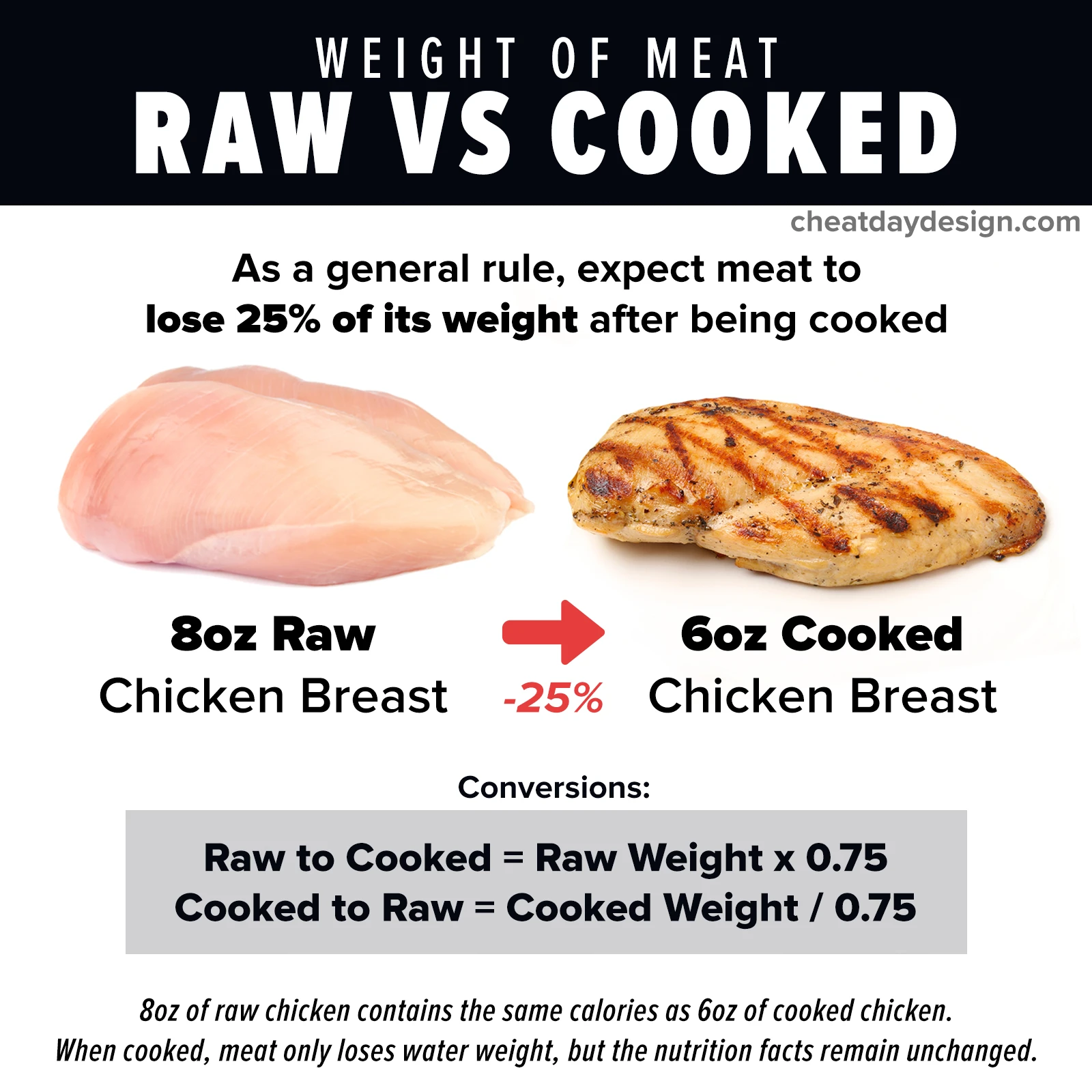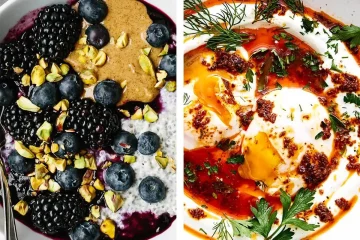All nutritional values in this blog post are based on products available from Wegmans unless otherwise states. Exact nutrition will depend on the cut & trim of each individual piece of chicken.
Chicken is a great source of lean protein, so it’s no wonder why it’s the staple of many high-protein diets (with the exception of vegan diets, of course).
No matter what your health or fitness goals are, odds are that you’ll be aiming to eat a fair amount of protein in the healthiest way possible.
While chicken is certainly a good choice, not all chicken is the same.
Depending on the cut, the way it’s prepared, the size, and whether or not there is skin, the calories in chicken can vary quite a bit.
While chicken is a great source of protein regardless of those variables, some are certainly better than others. Let’s break ’em down.
By the way, if you’re unsure of how much protein you should be aiming to consume, you can use my free macro calculator to get my recommendations!

How to Measure A Serving of Chicken (Raw vs Cooked)
For the purposes of these breakdowns, we’re looking at raw chicken (with the exception of rotisserie chicken).
When you look at the nutrition label of the chicken, the label will always display the raw weight of the chicken unless otherwise specified.
So, when you see that your chicken breast contains 110 calories for 4oz, that is 4oz of RAW chicken.
But what if you have already cooked your chicken breast? Is it still 4 ounces of chicken breast?
The weight of meat actually changes once cooked (I have a handy guide for that here) but it’s a very simple calculation to figure out just how much weight the chicken loses:

You can safely assume that will lose about 25% of its weight compared to the raw weight.
The 25% is certainly not an exact science as it will depend on the cut of chicken, the method, etc, but 25% will be very close.
So, when you cook 8 ounces of raw chicken breast, it actually becomes 6 ounces of grilled chicken breast.
If you were to measure out 8 ounces of cooked chicken on your kitchen scale, you’d actually be consuming closer to 11 ounces of chicken, because we base the calories on the raw weight.
I know, it can seem confusing, but I promise it’s very simple. Here’s a very simple way to look at it:
When cooked/exposed to heat, the chicken loses water weight and shrinks a bit. It’s the same as if you were to sit in a sauna and sweat a whole bunch. At the end of the session, you’ll weigh slightly less because you lost water weight, but nothing else about your body composition changes.
And to clear up any possible confusion: this change in weight does NOT change the calories or nutrition. Since it’s just water being lost, 8 ounces of raw chicken contains the same calories as 6 ounces of grilled chicken.
To get a sense of roughly how large this portion of chicken is, you can reference the visual hand guide:

6 ounces of cooked chicken will be enough to cover roughly both your palms.
This is not an exact science, of course, as we all have different hand sizes. But, this is a simple way to get a close approximation.
How Much Protein is ACTUALLY in an 8oz Chicken Breast?
When it comes to eating lean protein, chicken breast is the standard.
And when we’re talking about a serving of chicken breast, we’re generally talking about an 8-ounce chicken breast.
The only problem is, depending on your source, you’ll find the protein content for chicken breast ALL over the map, so I’m here to help. We’ll dive into the full nutritional value of chicken in the upcoming sections, but we need to start with the protein in chicken breast because it tends to be the most confusing.
If you’re tracking your macros and you turn to your favorite macro-tracking app like MyFitnessPal, you’ll find that the protein will vary greatly for 8 oz of chicken breast.
To solve this once and for all, I’ve searched the internet to find 15 different sources for the macros in 8oz chicken breast. Here’s what we’ve got:
The nutrition facts vary a bit based on the source, although there are all relatively similar. Since chicken breast can be trimmed a bit differently, it makes sense to see the protein and fat varying a bit.
To find the exact protein in an 8oz chicken breast, we’ll use the average of all of these sources to get a very close estimation (this is the strategy I use when estimating calories at restaurants, too).
Based on these averages, here is exactly how much protein is in an 8oz boneless skinless chicken breast:

240 Calories, 4g Fat, 0g Carbs, 51g Protein
Based on the average nutrition facts from fifteen different sources
Next time you need to track the macros of your chicken breast, use 240 calories and 51 grams of protein as your amounts and never second-guess yourself again.
Full Nutrition Facts for Chicken Breast

is the leanest part of the chicken you can eat, with very little fat (depending on how well it is trimmed, of course).
Chicken breast is mostly all protein, so if you’re looking to maximize your protein intake, it’s one of the best options out there.
8 Ounces of Boneless Skinless Chicken Breast (Raw)
240 Calories, 4g Fat, 0g Carbs, 51g Protein
8 Ounces of Bone-In Split Chicken Breast (Raw)
280 Calories, 9g Fat, 0g Carbs, 52g Protein
Skinless & boneless chicken breast is the leanest cut you can have. An 8-ounce chicken breast contains only 240 calories and 51 grams of protein, you’d be hard-pressed to find a better protein source out there.
In fact, for a lot of people, an 8-ounce chicken breast contains almost enough protein to cover half their daily value (100 grams is a fair goal for many people’s daily diet).
If you have the same amount of bone-in & skin-on chicken breast, it’s not going to be quite as lean. While you will end up getting roughly the same amount of protein for the same serving of food, you’ll also get slightly more calories & fat.
Remember: this is for a raw 8-ounce chicken breast. Once cooked, the same chicken breast will weigh 6oz. So, if you’re someone who tracks macros and weighs their food, make sure you’re measuring appropriately!
If you were to weigh 8 ounces of grilled chicken breast, it would actually be closer to 300 calories and 65 grams of protein.
Full Nutrition Facts for Deli Chicken

‘re searching for a lean, high-protein option for lunch, deli chicken is a very easy way to hit your daily protein goals.
By thinly slicing lean chicken breast, you can pack a ton of protein onto a sandwich.
6 Ounces of Sliced Deli Chicken
150 Calories, 3g Fat, 0g Carbs, 33g Protein
You’ll find slightly different versions of deli chicken at most delis, like buffalo chicken or teriyaki chicken, but it will always be a very lean source of protein from chicken breast.
Full Nutrition Facts for Chicken Thighs

Chicken thighs are generally considered less “lean” than chicken breast because they are dark meat.
For the longest time, I would avoid chicken thigh at all costs and only opt for chicken breast because I considered dark meat to be significantly less healthy than white meat and thought it was basically like eating red meat.
But chicken thighs are actually one of the most popular cuts of chicken, and it’s clear why…
8 Ounces of Boneless Skinless Chicken Thighs (Raw):
360 Calories, 18g Fat, 0g Carbs, 44g Protein
8 Ounces Bone-In Chicken Thighs (Raw):
380 Calories, 24g Fat, 0g Carbs, 42g Protein
Looking at a skinless chicken thigh (without the bone) we can see that it definitely has more fat than a chicken breast, but very similar protein content.
But, because of that extra fat content, it has so much flavor. In my opinion, it tastes far superior to chicken breast, and the extra calories are worth it.
If you’re dieting, you’ll likely want to stick with lean chicken breast, but chicken thighs are a delicious way to hit your protein goals.
Personally, I prefer to buy boneless skinless chicken thighs because they are significantly easier to cook. But as you can see here, even if you buy bone-in chicken thighs with the skin, the nutritional values are very similar.
Full Nutrition Facts for Chicken Wings

Ah, chicken wings. One of my favorites!
Note that we’re looking at a full chicken wing here. If you go out to a sports bar and order wings, you’ll be getting “party wings” which are split into smaller drums and flats, which I’ll break down below.
This is the full wing that you’ll end up getting if you were to order a bucket of chicken.
8 Ounces of Chicken Wings (Raw):
400 Calories, 26g Fat, 0g Carbs, 40g Protein
As you can see here, whole wings are considerably less lean than chicken breast or chicken thighs.
If you’ve ever eaten wings, you know why: they’re comprised of mostly skin, but that is where the flavor is! If you’re ordering from a restaurant, you’re likely eating skin-on wings. But if you were to remove the skin and eat just the meat inside, a 4 ounce portion of meat is quite lean- very similar to a chicken breast.
When it comes to wings, you don’t get a ton of meat per wing. Since the skin takes up much of the portion size, you end up getting more fat and not quite as much protein.
You can certainly remove the skin from the chicken wings to save calories, in which case you’d end up getting much leaner chicken out of it, but you’d be sacrificing flavor.
Full Nutrition Facts for Flats & Drumettes (Chicken Wing Parts)

When you go out to order wings, you’ll have two options: drums and flats. Flats, which you see pictured here, are always my go-to.
Drumettes are the other portion of the wing that you’ll get, and they look like little drumsticks.
8 Ounces of Chicken Wing Pieces (Raw):
380 Calories, 22g Fat, 0g Carbs, 44g Protein
Considering these are still part of the whole chicken wing, it’s not a surprise to see them relatively high in fat.
When it comes to weighing out portions of chicken wings, it becomes a bit difficult with the bones. We can’t simply weigh 8 ounces of wings, because you end up getting much less meat than 8 ounces due to the weight of the bones.
To make things simple, I like to assume that each wing weighs 1oz.
If you want to eat 8 ounces worth of raw chicken (remember that we use the raw weight in our nutritional values) then I would eat 6 wings, which is the same weight as 8 wings raw.
Full Nutrition Facts for Drumsticks

Chicken drumsticks are the other part of the chicken leg that is attached to the chicken thigh.
If you compare a chicken drumstick to whole wings, you’ll find the nutrition to be very similar. Being darker meat, there is some fat involved, but still very high amounts of protein.
8 Ounces of Drumsticks (Raw)
360 Calories, 20g Fat, 0g Carbs, 40g Protein
Sizes of drumsticks can be all over the map since chickens are obviously different sizes, so the exact serving size is going to vary.
There’s no exact rule as to how many drumsticks equate to 8 ounces of meat, but you’ll generally need about 4 drumsticks to get the same amount of meat as a chicken breast.
Full Nutrition Facts for Rotisserie Chicken

Of all the types of chicken, a rotisserie chicken is the toughest to estimate calories & protein of. Since it is a whole chicken, it is going to depend entirely on which parts you are consuming.
As you’ve seen in this guide, the calories in chicken vary quite a bit depending on the part of the chicken.
But, if you eat a mix of white & dark meat rotisserie chicken, here’s how the nutrition shakes out:
6 Ounces of Cooked Rotisserie Chicken
360 Calories, 22g Fat, 0g Carbs, 40g Protein
Full Nutrition Facts for Fried Chicken
While chicken is often enjoyed grilled or roasted, it’s also commonly served in other different ways, such as breaded and fried.
While it’s still lean meat, the calories and grams of fat will differ when chicken is deep-fried.
I put together a quick guide for different parts of the chicken, and different preparations, based on the KFC menu. Let’s check it out…

The biggest takeaway here is seeing how different fried chicken is from grilled or baked chicken.
Let’s look at the example of a chicken breast.
The fried chicken breast at KFC (original recipe) is 390 calories, 21g fat, 11g carbs, and 39g of protein.
The grilled chicken breast (that KFC no longer offers) was 210 calories, 7g of fat, 0g carbs, and 38g of protein.
As you can see, the calories and fat (including saturated fat) are significantly higher for fried chicken, and the breading adds extra carbs as well.
So remember: not all chicken is created equally. The way it’s prepared and cooked, and the level of trimming done, can all greatly impact the final calorie counts.
Is Chicken Good for Weight Loss?

In short: absolutely!
On its own, chicken is a really good source of lean, complete protein (a protein containing all essential amino acids).
Whether your goals involve losing fat or adding muscle mass, chicken is one of the best high-protein foods you can choose and a great way to keep your protein intake high.
Even if we’re looking at a serving of dark meat with skin-on, the high protein is going to be sure to keep you full and satisfied, which is hugely important when you’re dieting and your calories are low.
Of course, some options will benefit you more than others when it comes to weight loss.
If you can help it, try to stick with grilled chicken. While chicken breast is your best option for low calories and high protein, the other parts of the chicken are certainly not bad to enjoy.
As we discussed, just pay attention to the way they’re prepared.
or baked can also be great options. If the baked is breaded like , just be mindful that the breading will add extra calories. When you order fast , you’ll notice that the and fried are actually a bit lower in protein as well because the breading takes away from the overall quantity of the inside.
When the goal is lower calories, it’s best to limit the consumption of fried chicken when possible, since it will come with extra, unwanted calories.
It’s also important to pay attention to what you pair your chicken with. Since chicken can be lacking flavor (unless you have a great recipe to spice things up) you may want to pair it with something very flavorful.
In a lot of cases, you’ll find chicken paired with mashed potato, corn, prepared as a sandwich, smothered with sauce, etc, so it’s important to be mindful of your pairings.
Vegetables make a great side to grilled chicken, and if you season it all up properly, you can have an absolutely delicious, low-calorie meal very easily!





